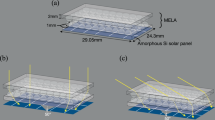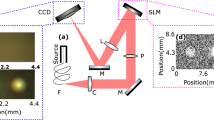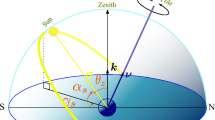Abstract
THEflux at the surface of the Sun, ∼6.3 kW cm-2, falls off with the square of distance to a value of ∼137 mW cm-2 above the Earth's atmosphere, or typically 80–100 mW cm-2 at the ground. In principle, the second law of thermodynamics permits an optical device to concentrate the solar flux to obtain temperatures at the Earth's surface not exceeding the Sun's surface temperature. In practice, conventional means for flux concentration fall short of this maximum because imaging optical designs are inefficient at delivering maximum concentration. Non-imaging light-gathering devices can improve on focusing designs by a factor of four or more, and approach the thermodynamic limit. We have used a non-imaging design to concentrate terrestrial sunlight by a factor of 56,000, producing an irradiance that could exceed that of the solar surface. This opens up a variety of new applications for making use of solar energy.
This is a preview of subscription content, access via your institution
Access options
Subscribe to this journal
Receive 51 print issues and online access
$199.00 per year
only $3.90 per issue
Buy this article
- Purchase on Springer Link
- Instant access to full article PDF
Prices may be subject to local taxes which are calculated during checkout
Similar content being viewed by others
References
Welford, W. T. & Winston, R. The Optics of Nonimaging Concentrators, (Acacemic, New York, 1978).
Winston, R. & Welford, W. T. J. Opt. Soc. Am. 69, 532–536 (1979).
O'Gallagher, J., Winston, R. & Welford, W. T. J. Opt. Soc. Am. A 4, 66–68 (1987).
Gleckman, P. Appl. Opt. 27, 4385–4391 (1988).
Gleckman, P., Winston, R. & O'Gallagher, J. Proc. A. Meet. Am. Solar Energy Soc. (ed. Coleman, M. J.) (Cambridge, Massachusetts, 1988).
Winston, R. Appl. Opt. 15, 291–292 (1976).
Golger, A. L. & Klimovskii, I. I. Sov. J. Quantum Electron. 14, 164–179 (1984).
Arashi, H. et al. Jap. J. appl. Phys. 23, 1051–1053 (1984).
Weksler, M. & Shwartz, J. IEEE J. Quantum Electron 24, 1222–1228 (1988).
W. A. Couch (ed.) Proc. A. Solar Thermal Technology Research and Development Conf. Washington, DC (US Department of Energy, 1989).
Author information
Authors and Affiliations
Rights and permissions
About this article
Cite this article
Gleckman, P., O'Gallagher, J. & Winston, R. Concentration of sunlight to solar-surface levels using non-imaging optics. Nature 339, 198–200 (1989). https://doi.org/10.1038/339198a0
Received:
Accepted:
Issue Date:
DOI: https://doi.org/10.1038/339198a0
This article is cited by
-
Solar energy needs focus
Nature (2016)
-
Photon energy upconversion through thermal radiation with the power efficiency reaching 16%
Nature Communications (2014)
-
Carbon modified (CM)-n-TiO2 thin films for efficient water splitting to H2 and O2 under xenon lamp light and natural sunlight illuminations
Journal of Solid State Electrochemistry (2009)
-
Sunlight brighter than the Sun
Nature (1990)
Comments
By submitting a comment you agree to abide by our Terms and Community Guidelines. If you find something abusive or that does not comply with our terms or guidelines please flag it as inappropriate.



